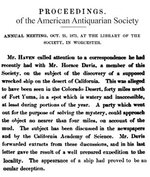Spanish Galleon in the Desert
Somewhere in the rugged desert wasteland of Imperial County in Southern California lies the long-dead skeleton of an old Spanish galleon, its sun-bleached timbers jealously guarding its million dollar fortune in fabulous pearls.
http://www.sandrazor.com/images/treasure/pages/pearls1.htm
Somewhere in the rugged desert wasteland of Imperial County in Southern California lies the long-dead skeleton of an old Spanish galleon, its sun-bleached timbers jealously guarding its million dollar fortune in fabulous pearls.
http://www.sandrazor.com/images/treasure/pages/pearls1.htm






 I've gotten coins back to barbers and IHs there in parks in those towns.
I've gotten coins back to barbers and IHs there in parks in those towns.


